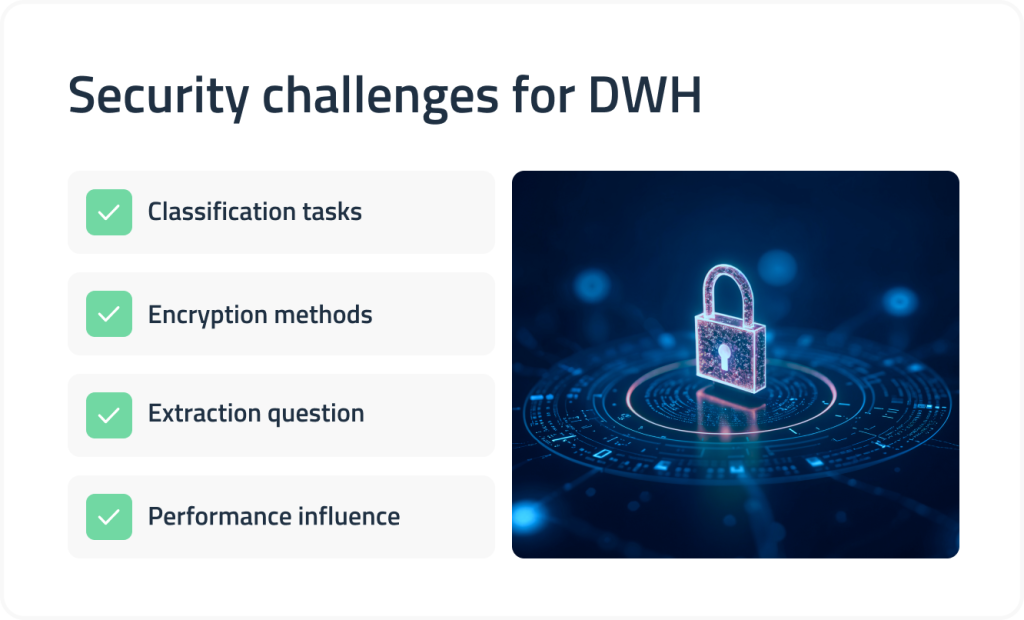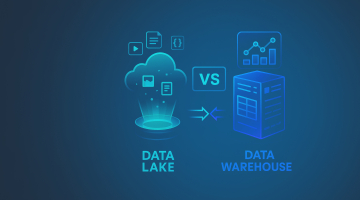

Data warehouse security: How to avoid DWH security issues
Which factors do you consider the most threatening for a business? Financial risks? Competitors? Disruptive technologies? Surely, these aspects are important, but cybersecurity issues remain the most dangerous and devastating. Grasp the number: 1.76 billion personal records were leaked in January 2019 alone! The costs of hacker attacks are billions of dollars, while the global cost approaches several trillion. No enterprise can feel safe now, so DWH privacy matters.
We realize how essential data warehouse security is. Working with banks and insurance companies, our developers must design flawless systems to protect business and customer-sensitive data. In this guide, we share the knowledge gathered over years of experience. You will learn about privacy basics and challenges and ways to improve your data warehouse protection, including encryption methods and hardware-based approaches.
Read more: How to implement a DWH for bank
Understanding DWH privacy
A data warehouse (DWH) is software that collects business information from several sources. Put simply, it’s a repository. It stores data, provides quick access, and helps in analysis. It also must be safe. And here comes the main problem.
In a nutshell, DWH privacy is similar to this aspect in other systems. Protected apps should prevent unauthorized access and hacker attacks, while employees should be able to access the required data when they need it. However, too strict access would interfere with users’ seamless use of the information. Moreover, security always affects performance.
Business owners should care about the protection of the company’s/users’ data before building databases. Pay attention to the ways you’re going to use the data. For instance, warehouses focused on selling data should feature separate access levels for each client. Simultaneously, bases for internal work should prioritize quick and error-free processes.
Thus, data warehouse security boils down to developing and implementing efficient mechanisms that ensure the availability, integrity, and confidentiality of records stored in on-premises or cloud-based data warehouses. Confidentiality is the primary concern.
Before we analyze how the data warehouse security posture can be maintained and augmented, it is necessary to understand the difference between various data storage facilities, namely a database and a data warehouse.
Experiencing a lack of technical expertise and skills?
Connect with a professional team to address your project challenges.
A database vs a data warehouse: A brief comparison
As vetted experts in data warehousing, we would like to draw a clear-cut distinction line between these types of data depots.
A database is a more general term. It describes any central data repository honed to keep it safe and guarantee seamless data access on demand. It contains real-time data in various formats, including separate tables, texts, XML, CSV files, and Excel spreadsheets. As a rule, databases are organized as OLTP facilities and directly linked to a front-end application (one database per one application). They employ specialized software programs called database management systems (DBMS) for data classification, movement, and governance.
A data warehouse is a specific type of database relying on OLAP mechanisms. It accumulates real-time and historical data from multiple source systems, organizing it for further use. And this usage is what differentiates a data warehouse from a database. While the job functions of a database are limited to storing data and retrieving it when necessary, a DWH goes a step further, provisioning its content for up-to-date reporting, advanced analytics, and business intelligence. Being separated from front-end applications, data warehouses allow for the scalability and regular update of the stored data, which turns them into a second-to-none foundation for analyzing historical and current trends and delivering actionable insights for data-driven decision-making.
Besides, the denormalized nature of data kept in a DWH positively affects the data warehouse’s performance when responding to large analytical queries compared to a database. A database can take several minutes to complete, whereas a DWH with an appropriate bandwidth can handle them in a split second.
Yet, whether it is a database or a data warehouse, the system requires strong security features and properly documented security policies to avoid data breaches, safeguard intellectual property rights, and provide rock-solid sensitive data protection. Let’s consider the implications of robust security measures for functioning a data warehouse and the organization that owns a DWH.
Pros and cons of security in data warehousing
What are the assets of providing high-level data security in data warehouses?
- Mitigation of financial and reputational damage. By protecting certain data types (mainly sensitive information concerning customers as well as classified business data), organizations avoid hefty expenditures and scandals affecting their public image and brand name. Besides, they save on attorney costs and direct monetary losses that may follow the failure to protect sensitive data from compromise.
- Strong compliance. Regulatory bodies that spot a company’s inability to adhere to various legal security requirements may also fine it. A robust security contour of a data warehouse reduces such possibilities and allows enterprises to stay within the legal framework in their vertical.
- Data integrity and quality are superb. By implementing stringent access restrictions to data catalogs and providing clear audit trails and transparent audit logs, companies not only boost data loss prevention but also improve the accuracy of decisions made with data stored in an adequately protected DWH.
- Increased consumer trust. Clients are more likely to cooperate with a company whose virtual private networks and data storage facilities guarantee the inviolability of their personal and financial data. As a result, such businesses enjoy greater customer loyalty and a reliable brand image.
Alongside evident perks, there are some downsides to organizations’ efforts to secure data warehouses they employ as pivotal elements of their digital ecosystem.
- Considerable investments. Implementing security measures isn’t a chump change issue (especially if you involve cutting-edge technologies like AI), and the more advanced the level of these measures is, the more budget you will need. Small and medium-sized businesses may find the cost forbidding, but this is the price you must willingly pay to feel safe about your DWH’s impregnability.
- More complicated workflows. All operations with your DWH and its data may become more intricate after your security policies are carried out, so data governance and data warehouse maintenance will become more challenging for your personnel.
- Reduced corporate agility. Multi-layered access control mechanisms required for high-level DWH security will inevitably slow down the speed of decision-making and overall performance efficiency within your organization.
When devising your DWH security strategy, you should also have a clear vision of the roadblocks and bottlenecks you will encounter.
Crucial security challenges for data warehouses
Let’s look at the current issues of data warehouse modeling and protection. Apart from the aforementioned importance of balancing between smooth access and security measures, there are a few other points:

- Classification tasks: define the user clusters to provide them with correct access. This point may include employees only or include customers and partners, too.
- Encryption methods: it’s all about tech things. Managers should get the best software/hardware combination to keep low costs and set high quality.
- Extraction question: databases not only store info but allow users to view it, exchange, upload, and download it. Security measures should consider these weak links.
- Performance influence: the more complicated and protected a system is, the more resources it requires. Heavy loads lead to crashes and, potentially, other leaks.
In 2024, researchers surveyed more than 4,000 companies from several countries in the report published by Hiscox. The results revealed that 40% of American companies believe that their cybersecurity system still struggles with developing formal procedures and lacks training and awareness among personnel, with the maturity of their cyber resilience being at the ad hoc or even basic level.
That is why they are still «cyber novices,» more susceptible to hacker attacks. To deal with the listed challenges and become at least ” cyber intermediaries,» businesses should start with the architecture of the planned system.
Data warehouse architecture aspects
Just trust us: it’s much easier to build a robust and protected platform than to redesign it to improve DWH privacy, add new features, or upgrade security layers later. Naturally, enterprises grow by acquiring new clients or partners. This process leads to new data sources and access levels. Without proper initial planning, you will have to add security measures and set access for all the new partners, spending extra resources.
Hence, let’s think about how to build a reliable database at the beginning. According to data warehouse modeling, there are four key activities to remember.
1. User accesses
There’s a system of access layers to start with. They can be set based on different criteria, e.g., data types, job functions, the company’s hierarchy, or employees’ roles. When you design the warehouse, you should consider the data people will access and then classify the information and the end-users.
There are two data classification approaches:
- Sensitivity-based. Highly sensitive personal information will be restricted, while generic data will be available to more users.
- Function-based. Specific user categories will be able to access only the data they need for their work. Other information will be blocked.
And two user classification methods:
- Hierarchy-based. This model is suitable for enterprises with a few departments. Thus, you can create data marts with unique access for each team, where data access with specific row-level security or column-level security protocols is enabled.
- Role-based. If a company has many branches requiring the same data, it’s better to set accesses based on roles: administrators, developers, analysts, etc.
Managers can build a comprehensive yet scalable data warehouse architecture by choosing one method or combining several of them. Remember that new data/user types may appear over time, and use universal classes.
Need a data warehouse? Learn how to build a data warehouse from scratch.
2. Data load and movement
Data is most often compromised when an employee accesses it. Sometimes, hackers get quicker access to restricted areas when packages are uploaded or downloaded. Also, workers can steal sensitive info directly. In April 2019, more than 540 million Facebook private records were found on public Amazon cloud servers. It’s a bright example of poor security during data exchange between platforms.
To keep DWH privacy at a high level, answer questions related to different aspects of data movement:
- Where are the basic files stored? Who has access to these directories?
- Are there backups? How are they stored, and who has access to them?
- How do you work with temporary data? Where are the query results stored?
Regardless of data type, remember to maintain the same security standards. For instance, regular employees can often make a query and get temporary tables with restricted information. This is unacceptable.
3. Network requirements
Besides the user and data security, we shouldn’t forget about tech stuff. Data warehouse modeling provides for designing and connecting a reliable infrastructure. To make your network safe, plan how the data will flow across the organization, the ways you will send and receive info, and what type of encryption you will use (if any).
Our data science professionals have worked with many systems based on poor data warehouse architecture. One of the most common issues is poor scalability. Enterprises use advanced encryption methods, but forget that large data packages require more processing power over time. That’s why planning the structure is essential before creating the DWH.
Best practices to reach top safety
Well, now, let’s move to the exact tips and tricks! Despite serious challenges and many concerns to foresee, it’s possible to build a reliable, safe, and robust data warehouse. Further, we list efficient, time-proven approaches to maintaining perfect security. On the most basic level, these options are divided into hardware and physical measures and software-based ones. We will focus on both aspects.
Hardware
Physical conditions and database protection may look less important than the digital side. However, they also form a crucial security level. All software decisions would be obsolete if a fraudulent employee could access the data warehouse physically and damage or steal valuable information. Hardware-focused solutions come down to three points:
- Control physical access to the warehouse. Advanced identification methods exist for this. Biometric readers, scanners, cameras, and other devices can prevent unauthorized server access.
- Set standardized security protocols. Ensure that all the employees (and guests) know the company’s protocols. They should obey these rules all the time. Standards should be clear, understandable, and practical yet justified.
- Use only reliable hardware pieces. Old systems may fail to provide reliable security because of simple hardware issues. Servers often go down under high loads, processors burn, and whole networks are disabled, making it easier to break in.
While top-notch physical DWH privacy is often a must, we suggest managers calculate expenses carefully. It’s illogical to build a defense that costs several billion when the estimated losses from a data leak are a few million. Still, large companies should invest in physical defense. For example, three billion compromised Yahoo accounts resulted in $350 million in damage. It’d most likely be cheaper to prevent this attack.
Software
The primary battle between cybersecurity specialists and hackers occurs in the digital world. Hardware acts as a basis, but the software is a key factor. Let’s look at the most useful safeguards that refer to data warehouse architecture, access points, and users:
- Data encryption. The most basic protection layer provides for using encryption methods to make data unreadable to outsiders. Encrypting info on a transactional basis is obligatory. Moreover, it’s also better to use encryption in the basic DWH. You may use AES algorithms and software certified with FIPS 140-2.
- Data movement protection. Today, a lot of data is stored in cloud systems like Google Cloud, AWS, Microsoft Azure, or facilities run by other providers that offer public cloud services to enterprises and individuals. Businesses must surely move it, share it with partners, copy it, and so on. To protect on-the-move data, use traditional protocols, such as SSL and TSL. Also, try to integrate VPNs for even higher safety online.
- Data classification. According to user access, all warehouse data should be classified. Feel free to use the method you like the most: by functions, by departments, etc. Data partitioning is required, too. It’s based on sensitivity and separates the most sensitive information from other packages.
- Role-based control. In addition to data classification, remember user roles and privileges. Set rights for different classes so unauthorized employees can’t make SQL requests, create temporary tables, or download data. Be sure to protect the administrator’s profiles perfectly, as they can grant and disable access for other users.
- Virtual private databases (VPDs) are tools that allow setting security measures on tables, views, words, rows, columns, and more. VPDs limit access dynamically and attach protection to each object instead of the whole base. With this feature, bank customers would see only their transactions, and employees—only their salaries.
More information on the topic:
Big data in banking: Key benefits and main challenges
Similarly to hardware protection, don’t forget to calculate expenses. If the potential damage is low, don’t invest in costly solutions – you just don’t need them. Consider reputational losses here, too. For instance, banks are interested in advanced security systems even if they don’t have a lot of sensitive data in their storage. Protected banks are more demanded by customers, obviously.
Future trends
Numerous studies describe the idea of DWH privacy. According to the analysis, experts often discuss encryption, audit, transformation, views, multi-platform connections, and general data warehouse modeling. The majority of studies focus on extendibility and independence models, while the most popular approaches include encrypted queries, UML-, and XML-based security techniques.
We can predict that old approaches like Adapted Mandatory Access Control will disappear as cybersecurity professionals will introduce more efficient options. Our developers know the most innovative techniques and are ready to use them for your data warehouses. Feel free to contact us for a consultation, upgrade, or new custom DWH. Don’t wait, and protect your data today!
FAQ
Why is data warehouse security such a critical concern?
Modern companies use vast business and customer data, usually kept in on-premises or cloud-based data warehouses. If compromised, this sensitive information can cause significant financial and reputational damage to the organization. Besides, the inviolability of data is the primary focus of numerous legal regulations that organizations across various industries (especially banking, insurance, and healthcare) should comply with.
What are the most significant security challenges unique to data warehouses?
Companies aiming to provide maximum data warehouse security should handle the classification of tasks to which access will be restricted, the choice of data encryption methods, the ways users upload, download, and exchange information from the DWH, and the balancing of system loads that impact its performance.
How can you secure user access to a data warehouse?
First, you should ensure that only authorized employees have physical access to on-premises servers. As for the virtual storage itself, you should leverage sensitivity-based or function-based data classification approaches and employ hierarchy-based or role-based user access restrictions. It is recommended that these mechanisms be combined to provide maximum access control.
What are the best practices for securing data loading and movement within the DWH?
As the statistics prove, most data leakages and system compromises occur when data moves into or from the DWH. To minimize such chances, you should create a list of people with access to the repository, know the virtual place where the basic files are kept, control backups, understand where query results are stored, and determine employees who work with temporary data.
What hardware and software security measures should be prioritized?
To make your hardware safe, you should control physical access to your machinery, use only reliable equipment, and establish well-thought-out security protocols for all personnel trained to follow them. Software security measures include data classification and encryption, data movement protection, multi-factor system access authentication, and role-based access control.





